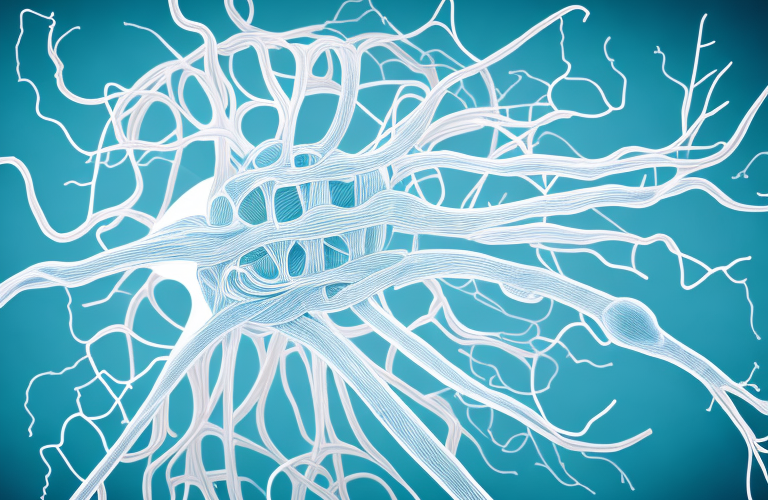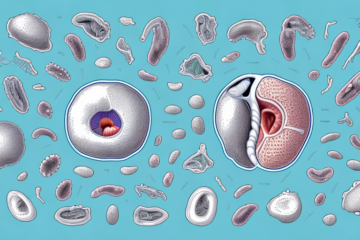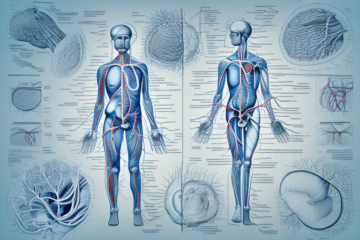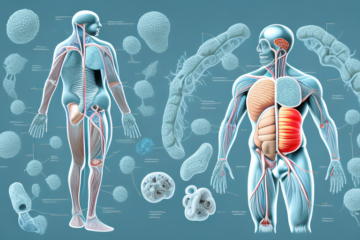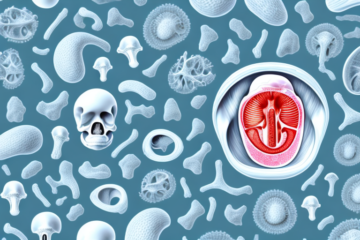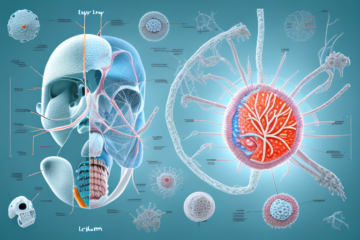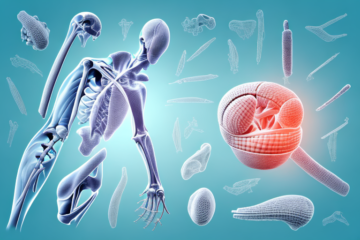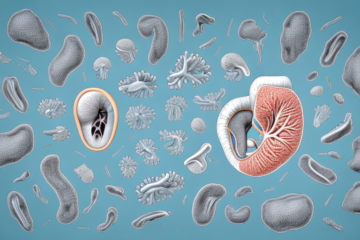Our nervous system is responsible for transmitting signals throughout our bodies, allowing us to move, think, and feel sensations. Understanding the complexities of nerve function and anatomy is crucial to maintaining optimal health and wellness. In this article, we will explore the basics of the nervous system function, the anatomy of nerves, different types of nerves and their functions, how nerve impulses trigger muscle contractions, as well as common nerve disorders and treatments.
The Basics of Nervous System Function
The nervous system is divided into two main parts: the central nervous system and the peripheral nervous system. The brain and the spinal cord make up the central nervous system, while the peripheral nervous system consists of all the other nerves in the body.
The nervous system communicates via electrical and chemical signals, known as nerve impulses, which pass through nerve cells, called neurons. This allows the nervous system to send messages from the brain to the rest of the body, and vice versa.
One important function of the nervous system is to regulate and control bodily functions, such as heart rate, breathing, and digestion. This is done through the autonomic nervous system, which is a part of the peripheral nervous system.
The nervous system also plays a crucial role in our ability to sense and respond to our environment. This is achieved through specialized cells called sensory receptors, which detect stimuli such as light, sound, and touch, and send signals to the brain for processing.
Understanding the Anatomy of Nerves
Nerves are made up of specialized cells called neurons, which are shaped like long, thin tubes. There are three main parts of a neuron: the cell body, dendrites, and axon.
The cell body contains the nucleus and other organelles, while the dendrites, which are numerous, receive signals from other neurons. The axon is a single, long branch that transmits signals to other neurons or to muscles and glands.
Neurons are not the only cells that make up nerves. There are also glial cells, which provide support and protection for neurons. There are several types of glial cells, including astrocytes, oligodendrocytes, and Schwann cells.
Astrocytes help to regulate the chemical environment around neurons, while oligodendrocytes and Schwann cells produce myelin, a fatty substance that insulates the axons of neurons and helps to speed up the transmission of signals. Without myelin, nerve impulses would travel much more slowly.
The Different Types of Nerves and Their Functions
There are three main types of nerves: sensory nerves, motor nerves, and mixed nerves. Sensory nerves transmit signals from the body to the brain, allowing us to feel sensations such as touch, heat, and pain. Motor nerves are responsible for controlling movements of muscles and other organs, while mixed nerves contain both sensory and motor neurons.
In addition to these three main types of nerves, there are also autonomic nerves that control involuntary functions such as heart rate, digestion, and breathing. These nerves are further divided into sympathetic and parasympathetic nerves, which have opposing effects on the body’s functions.
Damage to nerves can result in a variety of conditions, such as neuropathy, which can cause numbness, tingling, and pain in the affected areas. Nerve damage can also lead to paralysis or loss of muscle control, depending on which nerves are affected.
How Nerves Transmit Signals Throughout the Body
Nerves transmit signals using a process called action potential. This involves the movement of ions, such as sodium and potassium, across the nerve cell membrane, which generates an electrical charge that travels down the axon. When the electrical charge reaches the end of the axon, it triggers the release of neurotransmitters, which allows the signal to cross the gap, or synapse, between nerve cells.
Interestingly, different types of neurotransmitters can have different effects on the receiving nerve cell. For example, some neurotransmitters can excite the receiving cell, while others can inhibit it. Additionally, the same neurotransmitter can have different effects depending on the type of receptor it binds to on the receiving cell. This complexity allows for precise and nuanced communication between nerve cells, which is essential for proper functioning of the nervous system.
The Role of Neurons in the Nervous System
Neurons are the building blocks of the nervous system. They are responsible for transmitting nerve impulses and are highly specialized to perform this function. Some neurons, called interneurons, communicate only with other neurons, while others transmit signals from the senses to the brain or from the brain to muscles and organs.
Neurons are also responsible for the processing and integration of information. When a neuron receives a signal, it processes the information and decides whether to transmit the signal further or not. This process of integration allows for complex information processing and decision making in the nervous system.
The Importance of Myelin in Nerve Function
Myelin is a fatty substance that surrounds and protects nerve cells. It enhances the speed and efficiency of nerve impulse transmission and plays a critical role in neural function.
Myelin is produced by specialized cells called oligodendrocytes in the central nervous system and Schwann cells in the peripheral nervous system. These cells wrap around the axons of neurons, forming a protective sheath that insulates the electrical signals traveling along the axon. Without myelin, nerve impulses would be slower and less efficient, leading to a range of neurological disorders.
Myelin is also important for learning and memory. Studies have shown that myelin plays a crucial role in the formation and maintenance of neural circuits that underlie cognitive processes. In addition, myelin is involved in the regulation of neural plasticity, which is the brain’s ability to adapt and change in response to new experiences. Therefore, maintaining healthy myelin is essential for optimal brain function throughout life.
How Nerve Impulses Trigger Muscle Contractions
The nervous system controls muscle contractions through a process known as motor unit recruitment. When a motor neuron sends a nerve impulse, it triggers all the muscle fibers it is connected to, allowing for coordinated muscle contraction.
Motor unit recruitment is a complex process that involves the activation of multiple motor neurons to produce a muscle contraction. The size and number of motor units recruited depend on the force required for the task at hand. For example, lifting a heavy weight requires the activation of more motor units than lifting a lighter weight. This process is regulated by the brain and spinal cord, which constantly monitor and adjust the level of muscle activation to maintain optimal performance.
The Connection Between Nerves and Sensory Perception
Sensory nerves transmit signals from the body to the brain, which allows us to perceive sensations such as touch, pressure, and temperature. The brain interprets these signals and creates our experience of the physical world.
However, the connection between nerves and sensory perception is not always straightforward. In some cases, the brain can misinterpret signals from the nerves, leading to conditions such as chronic pain or phantom limb syndrome. Additionally, certain drugs or medical conditions can interfere with the transmission of nerve signals, leading to sensory deficits or even paralysis.
Research into the connection between nerves and sensory perception is ongoing, with scientists exploring new ways to understand and manipulate the complex interactions between the nervous system and the brain. By gaining a better understanding of how these systems work together, we may be able to develop new treatments for a wide range of neurological conditions.
Common Disorders Involving the Nervous System
There are numerous disorders that can affect the nervous system, including multiple sclerosis, Parkinson’s disease, Alzheimer’s disease, and epilepsy. Symptoms can include muscle weakness, tremors, vision loss, memory loss, and seizures.
It is important to note that some of these disorders can be genetic, while others may be caused by environmental factors such as exposure to toxins or head injuries. Treatment options vary depending on the specific disorder and may include medication, physical therapy, or surgery. Early diagnosis and treatment can greatly improve the quality of life for those affected by these disorders.
Treatments for Nerve-Related Conditions and Disorders
Treatments for nerve-related conditions and disorders can vary depending on the specific condition and its severity. Treatment options may include medications, physical therapy, surgery, or lifestyle modifications.
Medications are often used to manage nerve-related conditions and disorders. These may include pain relievers, anti-inflammatory drugs, and muscle relaxants. In some cases, antidepressants or anticonvulsants may also be prescribed to help manage nerve pain.
Physical therapy can also be an effective treatment option for nerve-related conditions. This may include exercises to improve strength and flexibility, as well as techniques to improve balance and coordination. In some cases, electrical stimulation or ultrasound therapy may also be used to help manage pain and improve nerve function.
Lifestyle Changes That Can Help Promote Optimal Nerve Health
Making certain lifestyle changes can help promote optimal nerve health. This may include getting regular exercise, eating a healthy diet, getting enough sleep, reducing stress, and avoiding harmful habits such as smoking and excessive alcohol consumption.
Another important lifestyle change that can promote optimal nerve health is maintaining a healthy weight. Being overweight or obese can increase the risk of developing nerve damage and other related conditions. Therefore, it is important to maintain a healthy weight through a combination of regular exercise and a balanced diet.
In addition, incorporating certain vitamins and minerals into your diet can also help promote nerve health. Vitamin B12, for example, is essential for nerve function and can be found in foods such as meat, fish, and dairy products. Other important nutrients for nerve health include vitamin D, magnesium, and omega-3 fatty acids.
Cutting-Edge Research on Nerve Function and Development
Researchers are constantly exploring new treatments and therapies for nervous system disorders. Recent advancements include stem cell therapy, gene therapy, and neuroplasticity training.
One area of cutting-edge research in nerve function and development is the study of neural networks. Scientists are investigating how neurons communicate with each other and how these networks develop and change over time. This research has the potential to lead to new treatments for conditions such as Alzheimer’s disease and Parkinson’s disease, which are characterized by disruptions in neural networks.
How to Take Care of Your Nervous System: Tips and Tricks
Keeping your nervous system healthy is key to overall health and wellness. This can be achieved by getting plenty of rest, engaging in regular exercise, eating a balanced diet, and taking steps to manage stress and anxiety.
In conclusion, understanding the complex workings of the nervous system is crucial to maintaining optimal health and wellness. By staying informed and taking care of our nervous system through healthy lifestyle habits and proper medical care as needed, we can help ensure a life of vitality and well-being.
Another important aspect of taking care of your nervous system is to avoid harmful substances such as alcohol and drugs. These substances can damage the nervous system and lead to long-term health problems. It is also important to protect your head from injury, as head injuries can cause damage to the brain and nervous system.
Additionally, practicing relaxation techniques such as meditation, deep breathing, and yoga can help reduce stress and promote a healthy nervous system. These techniques can also improve sleep quality, which is essential for the proper functioning of the nervous system.

